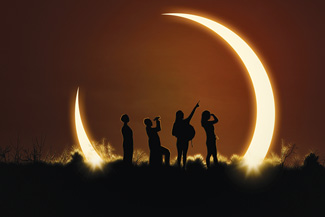Four minutes of night
 By DAN ZARLENGA
By DAN ZARLENGA
Missouri Department of Conservation
An immense, circular shadow moves over the land, blocking out the sun and revealing the brightest stars. It creates a 360-degree sunset, and in its wake, a path of night.
We all have the chance to witness an amazing natural sight next month, on April 8. Missouri will fall in the path of the second total solar eclipse within a decade. It’s incredibly unusual to have two such occurrences within the same area in so short a span of years.
It just so happens that Southeast Missouri will be in the right spot on Monday, April 8. Totality, the period when the moon completely blocks out the sun, will begin at 1:53 p.m. along the Arkansas border near the town of Thayer, Mo. The moon’s shadow will exit the state at 2:02 p.m. as it moves eastward over Ste. Genevieve. Locations in the center of this path will experience as much as four minutes of darkness.
HOW WILL NATURE RESPOND?
The event will draw thousands of people with eclipse viewing glasses in hand (never view the sun unless wearing the proper protection!). But what about the rest of nature? Humans have the advantage of knowing exactly what is happening. We can even predict it. How does a solar eclipse impact creatures that don’t have that benefit? What will they do during these four minutes of night in the middle of the day?
Many forms of wildlife respond just as they would during an actual sunset or nightfall. Disoriented by this false night, nocturnal animals like opossums, bats, and owls may appear from their daytime resting spots. Crickets, whip-poor-wills, and frogs have been known to begin performing their evening choruses of chirps and songs. As spring will just be beginning in early April, we could hear a brief, but rich symphony of birds and amphibians!
During the total solar eclipse of August 1932 that impacted several New England states, one witness observed that as totality reached its peak “the air was full of bees — a great roar of wings ensued and the entrances to the hives were blocked with bees trying to get in.” Researchers concluded that the insects were responding instinctively to rapid changes in light, temperature, and humidity.
Also, by instinct, domestic farm animals like cows have been known to return to their barns as totality begins, only to come right back out again minutes later when the ending of the eclipse mimics dawn.
Take advantage of the fact that this remarkable phenomenon will occur so close in our home state. On April 8, witness one of nature’s most dramatic spectacles. And while doing so, take a moment to observe the natural world around you. How will it respond during four minutes of night?



Leave a Reply